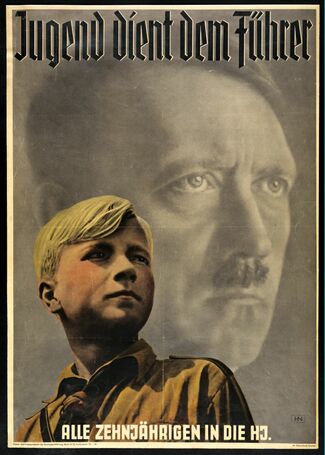Main article: Nazi Germany § World War II
Nazi Germany, led by Adolf Hitler, was the primary Axis Power in the European Theatre. German forces instigated the war in September 1939 by invading Poland. Poland was divided with the Soviet Union. The Phony War ensued and in the spring of 1940 German forces invaded and conquered Denmark, Norway, France, Belgium, Luxembourg, and the Netherlands. Attempts to subdue the United Kingdom by air in the summer of 1940 failed and a planned invasion was called off. In the summer of 1941 Germany turned its forces east by invading the Soviet Union. The Eastern Front became the main theatre of war for the Germans. The invasion of the USSR had been delayed by campaigns in Greece and Yugoslavia, aimed at assisting floundering Italian forces. The Afrika Korps was similarly dispatched to the Western Desert to assist struggling Italian forces there, and German forces grew to an entire army group. Major defeats at Stalingrad in February 1943 and the destruction of Axis forces in North Africa shortly after are commonly thought to be the war's turning points. German forces fought on Sicily, and when Italy switched sides, German forces seized power, fighting a successful withdrawal and diverting Allied forces from Northwest Europe. Severe losses at Kursk in the summer of 1943 and during the Soviet summer offensives of 1944 shattered German fighting power, and Allied landings in Normandy and Southern France forced the Germans to fight on several fronts simultaneously. The surrender of the German forces between 4 May and 8 May 1945, signaled the end of the war in Europe.
German forces were very active at sea, primarily through its submarine force. The German air force provided effective tactical and logistical support until Allied air superiority was achieved by the middle of 1944. Strategic use of airpower failed and despite heavy aerial bombardment (and later, the V-1 and V-2 rockets) of the United Kingdom, failed to achieve lasting results.
Hitler's war aims included the destruction of the Jews of Europe, and at the Wannsee Conference in early 1942, a system of extermination was finalized which led to the Holocaust.
Nazi Germany, led by Adolf Hitler, was the primary Axis Power in the European Theatre. German forces instigated the war in September 1939 by invading Poland. Poland was divided with the Soviet Union. The Phony War ensued and in the spring of 1940 German forces invaded and conquered Denmark, Norway, France, Belgium, Luxembourg, and the Netherlands. Attempts to subdue the United Kingdom by air in the summer of 1940 failed and a planned invasion was called off. In the summer of 1941 Germany turned its forces east by invading the Soviet Union. The Eastern Front became the main theatre of war for the Germans. The invasion of the USSR had been delayed by campaigns in Greece and Yugoslavia, aimed at assisting floundering Italian forces. The Afrika Korps was similarly dispatched to the Western Desert to assist struggling Italian forces there, and German forces grew to an entire army group. Major defeats at Stalingrad in February 1943 and the destruction of Axis forces in North Africa shortly after are commonly thought to be the war's turning points. German forces fought on Sicily, and when Italy switched sides, German forces seized power, fighting a successful withdrawal and diverting Allied forces from Northwest Europe. Severe losses at Kursk in the summer of 1943 and during the Soviet summer offensives of 1944 shattered German fighting power, and Allied landings in Normandy and Southern France forced the Germans to fight on several fronts simultaneously. The surrender of the German forces between 4 May and 8 May 1945, signaled the end of the war in Europe.
German forces were very active at sea, primarily through its submarine force. The German air force provided effective tactical and logistical support until Allied air superiority was achieved by the middle of 1944. Strategic use of airpower failed and despite heavy aerial bombardment (and later, the V-1 and V-2 rockets) of the United Kingdom, failed to achieve lasting results.
Hitler's war aims included the destruction of the Jews of Europe, and at the Wannsee Conference in early 1942, a system of extermination was finalized which led to the Holocaust.

